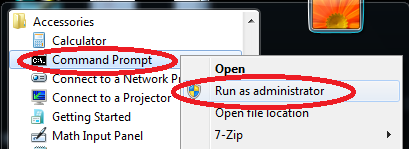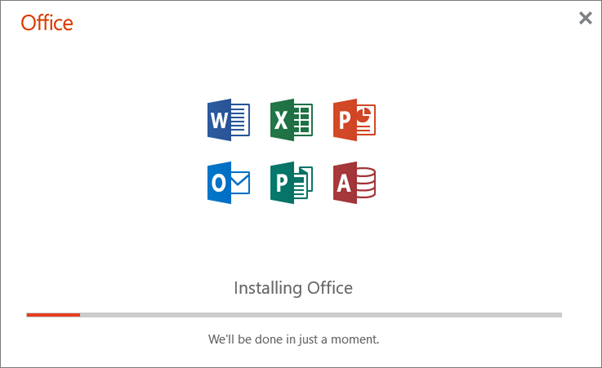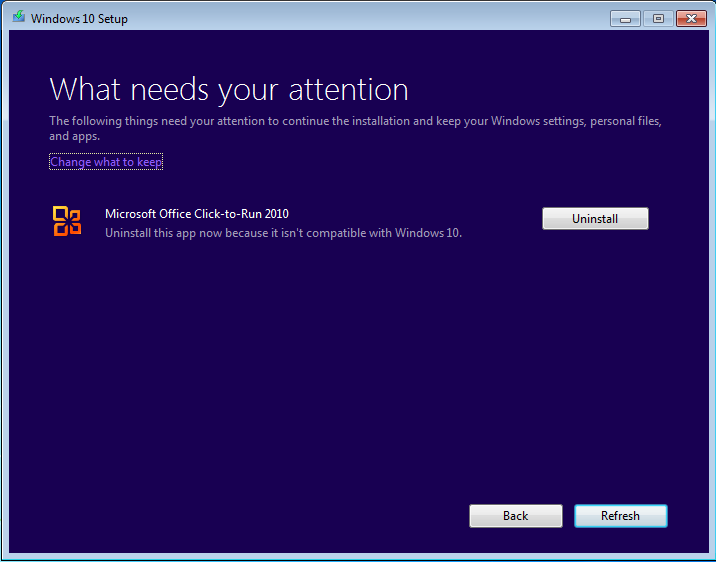The 32-bit version of Office is installed on a 64-bit version of the operating system. The Windows Search Service isn't installed. To resolve this issue, install the Windows Search Service. To do this, following the steps that are appropriate for your version of Windows. Windows 7 and Windows 8. Start Control Panel. We have 3 versions that can be considered currently 1. Office 2013 Professional 2. Office 2016 Professional 3. Office 365 Ill list all the features so that you can decide Office 2013. One time purchase. 3 years old. No future upgrades. Securit. The 32-bit version of Office is installed on a 64-bit version of the operating system. The Windows Search Service isn't installed. To resolve this issue, install the Windows Search Service. To do this, following the steps that are appropriate for your version of Windows. Windows 7 and Windows 8. Start Control Panel. It provided me MSCOMCTL.OCX (64 bit version 7.0.55.3227 found at 'C: Program Files Microsoft Office root vfs System' I am in Excel - Developer - Visual Basic environment. (Microsoft Visual Basic for Applications 7.1) Clicked on Tools - References. I could not get the Microsoft Windows Common Controls 7.0 loaded. Only for Windows 10 users. Win 7 and 8 users, open ReadMe.txt in the C2R-R2V folder; If Activation label stuck with MS Office 2016, ignored it; MS Visio 2019 and MS Project 2019 are downloaded separately; Microsoft Office 2019 32 Bit Free Download. Installer 32 Bit Google Drive MediaFire. File Size: 3.0 GB Password: www.yasir252.com.
Free Download Microsoft Office 2019 Professional Plus Retail-VL Version 2012 Build 13530.20316 (32-bit/64-bit) Multilingual for Windows PC [Direct + Torrent Magnet].
Languages: Arabic,English,German,Greek,French,Spanish,Italian,Portuguese-Portuguese,Portuguese-Brazil,Turkish
Download 64 Bit Office 365
It is the latest version of Microsoft’s productivity software. These Office products now use Click-to-Run, instead of Windows Installer (MSI), Office Professional Plus 2019 includes Access, Excel, Outlook, PowerPoint, Publisher, Word, and Skype for Business.

Overview of Microsoft Office Professional Plus 2019 Benefits
Office Professional Plus 2019 includes Access, Excel, Outlook, PowerPoint, Publisher, Word, and Skype for Business. There isn’t a 2019 version of OneNote, but OneNote 2016 is available for Office 2019.
We recommend that you uninstall existing versions of Office before you deploy Office 2019. If you’re uninstalling previous versions of Office products that were installed with Windows Installer (MSI), the Office Deployment Tool can remove most of those for you as part of the installation of Office 2019.
After downloading the installation files, internet access isn’t required to install, activate, or use Office 2019. There isn’t a 2019 version of SharePoint Designer or InfoPath. The last version for both products is 2013.
Office 2019 is a valuable update for customers who aren’t yet ready for the cloud. And each time we release a new on-premises version of Office, customers ask us if this will be our last. We’re pleased to confirm that we’re committed to another on-premises release in the future.
Overview of Microsoft Office Professional Plus 2019 – 2016 Features
This includes the following Office products:
- Microsoft Office 2019 Professional Plus
- Microsoft Access 2019
- Microsoft Excel 2019
- Microsoft Lync 2019
- Microsoft OneNote 2019
- Microsoft Outlook 2019
- Microsoft PowerPoint 2019
- Microsoft Publisher 2019
- Microsoft Visio Viewer 2019
- Microsoft Word 2019
- Skype for business 2019
- Office Shared Features
- Office Tools
- And many more
System Requirements and Technical Details


- Supported OS: Windows 7/8/10
- Computer and processor: 1.6 gigahertz (GHz) or faster, 2-core
- Memory: 4 GB RAM; 2 GB RAM (32-bit)
- Hard disk: 4.0 GB of available disk space
- .NET version: Some features may require .NET 3.5 or 4.6 and higher to also be installed
- Languages:English,German,Greek,French,Spanish,Italian,Portuguese-Portuguese,Portuguese-Brazil,Russian
Microsoft has changed their guidance to state that from September 2018 on, they recommend the 64 bit version of Office be installed. This is a departure from the 32bit guidance Microsoft provided previously.

After Microsoft first compiled a 64 bit version of MS Office in June 2010, they immediately told consumers and companies not to use it. The issue was not cost, stability or features; they were all the same as the 32 bit version. The issues with 64 bit Office were:
Install Office 365 64 Bit
- Your PC Operating System had to be 64 bit but in 2010 only about 90% of PC’s ran a 32bit version of Windows (see the table to the right).
. - There were no 64 bit plug-ins. If you had an addin for Outlook, Excel, Word… it was guaranteed to be a 32 bit plug in because that was all that existed at the time.
Microsoft also people that the only notable improvement from the 64 bit version of MS Office was that Excel could handle much larger spreadsheet. 64bit Office was about the future. In 2010, very few people had worksheets that came anywhere near the limits:

Maximum limits of memory storage and file size for Data Model workbooks 32-bit environment is subject to 2 gigabytes (GB) of virtual address space, shared by Excel, the workbook, and add-ins that run in the same process. A data model’s share of the address space might run up to 500 – 700 megabytes (MB), but could be less if other data models and add-ins are loaded.
64-bit environment imposes no hard limits on file size. Workbook size is limited only by available memory and system resources.
SOURCE
Fast forward about a decade and we find:
- “big data” means that 32bit size and speed limits are causing more and more frustrations with Excel
- You would really have to look hard to find a Windows 10 PC running 32bit Operating System
- Plugin developers have had nearly a decade to get 64bit plugins ready
In addition to Excel, Microsoft now indicates that the 64 bit versions of Office apps will perform notably better than their 32 bit counterparts if you are working with:
- Very large graphics in PowerPoint,
- MS Project files larger than 2GB
- “Large Data Type” in MS Access
To be clear, Microsoft says you should stay with 32 bit MS Office if:
- You have 32-bit COM Add-ins with no 64-bit alternative. You can continue to run 32-bit COM add-ins in 32-bit Office on 64-bit Windows. You can also try contacting the COM Add-in vendor and requesting a 64-bit version.
You use 32-bit controls with no 64-bit alternative. You can continue to run 32-bit controls in 32-bit Office like Microsoft Windows Common Controls (Mscomctl.ocx, comctl.ocx), or any existing 3rd-party 32-bit controls.
- Your VBA code uses Declare statements Most VBA code doesn’t need to change when using in 64-bit or 32-bit, unless you use Declare statements to call Windows API using 32-bit data types like long, for pointers and handles. In most cases, adding PtrSafe to the Declare and replacing long with LongPtr will make the Declare statement compatible with both 32- and 64-bit. However this might not be possible in rare cases where there is no 64-bit API to Declare. For more information about what VBA changes are needed to make it run on 64-bit Office, see 64-Bit Visual Basic for Applications Overview.
- You have 32-bit MAPI applications for Outlook. With a growing number of 64-bit Outlook customers, rebuilding 32-bit MAPI applications, add-ins, or macros for 64-bit Outlook is the recommended option, but if needed you can continue to run them with 32-bit Outlook only, as well. To learn about preparing Outlook applications for both 32-bit and 64-bit platforms, see Building MAPI Applications on 32-Bit and 64-Bit Platforms and the Outlook MAPI Reference.
- You’re activating a 32-bit OLE server or object. You can continue to run your 32-bit OLE Server application with a 32-bit version of Office installed.
- You’re using SharePoint Server 2010 and you need the Edit in Datasheet view. You can continue to use the Edit in Datasheet view functionality in SharePoint Server 2010 with 32-bit Office.
- You need 32-bit Microsoft Access .mde, .ade, and .accde database files. While you can recompile 32-bit .mde, .ade, and .accde files to make them 64-bit compatible, you can continue to run 32-bit .mde, .ade, and .accde files in 32-bit Access.
- You require Legacy Equation Editor or WLL (Word Add-in libraries) files in Word. You can continue to use Legacy Word Equation Editor and run WLL files in 32-bit Word.
- You have an old embedded media file in your PowerPoint presentation with no available 64-bit codec.
SOURCE